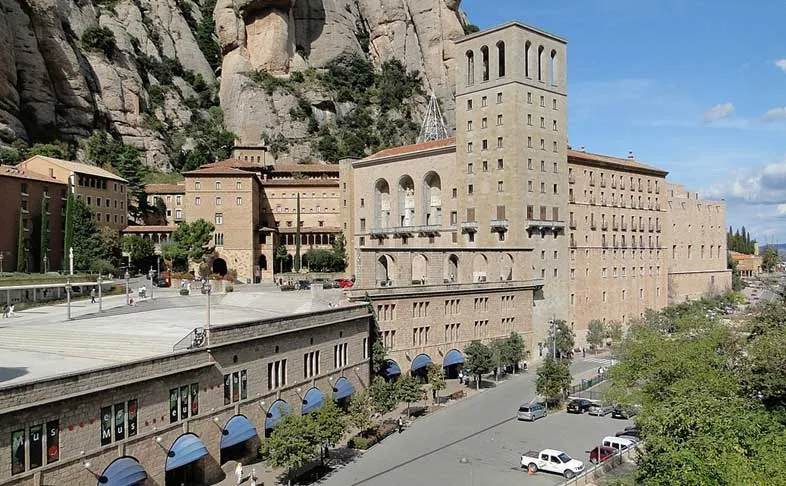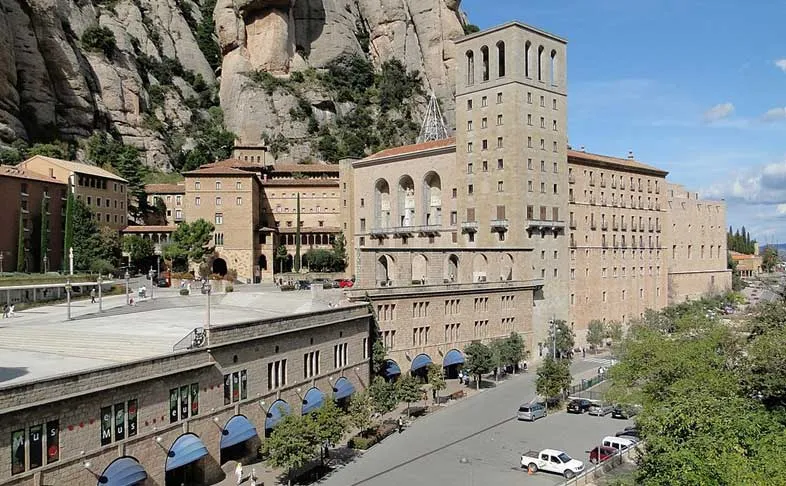
Introduction
Santa Maria de Montserrat is an abbey of the Order of Saint Benedict located on the mountain of Montserrat in Monistrol de Montserrat, Catalonia, Spain. It is notable for enshrining the image of the Virgin of Montserrat. The monastery was founded in the 11th century and rebuilt between the 19th and 20th centuries, and still functions to this day, with over 70 monks. There have always been roughly 80 monks in residence.
The monastery is 48 kilometres (30 mi) northwest of Barcelona, and can be reached by road, train or cable car. The abbey’s train station, operated by FGC, is the terminus of a rack railway connecting with Monistrol, and two funiculars, one connecting with Santa Cova (a shrine and chapel lower down the mountain) and the other connecting with the upper slopes of the mountain.
At 1,236 metres (4,055 ft) above the valley floor, Montserrat is the highest point of the Catalan low lands, and stands central to the most populated part of Catalonia. Montserrat’s highest point, Sant Jeroni, can be reached by footpaths leading from the monastery. From Sant Jeroni, almost all of Catalonia can be seen, and on a clear day the island of Mallorca is visible.
Montserrat, whose name means ‘serrated mountain’, is ideally located to play an important role in the cultural and spiritual life of Catalonia. It is Catalonia’s most important religious retreat and groups of young people from Barcelona and all over Catalonia make overnight hikes at least once in their lives to watch the sunrise from the heights of Montserrat.
The Virgin of Montserrat is Catalonia’s favourite saint, and is located in the sanctuary of the Mare de Déu de Montserrat, next to the Benedictine monastery nestling in the towers and crags of the mountain. The Escolania, Montserrat’s Boys’ Choir, is one of the oldest in Europe, and performs during religious ceremonies and communal prayers in the basilica.
The basilica houses a museum with works of art by many prominent painters. The Publicacions de l’Abadia de Montserrat, a publishing house, one of the oldest presses in the world still running, with its first book published in 1499.
History of Santa Maria de Montserrat Abbey
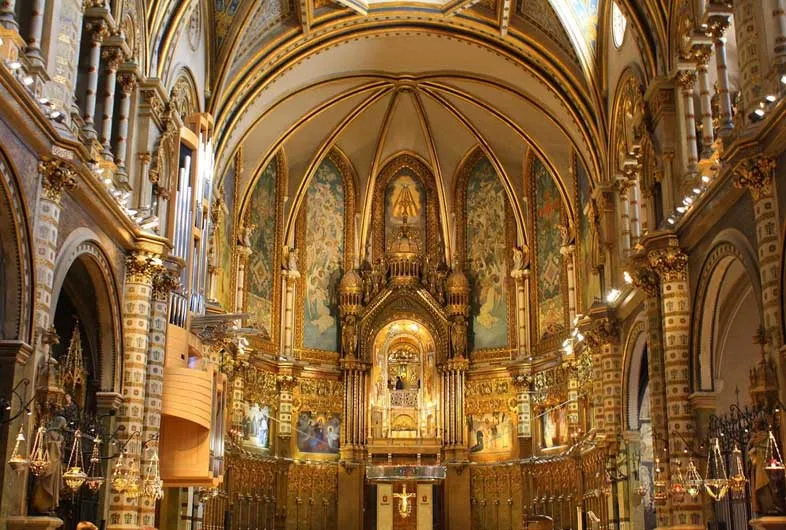
Initial construction of the basilica of Montserrat began in the 16th century, and its complete reconstruction began in the year 1811, after being destroyed in the Peninsular War.
In 1881 the Pope Leo XIII granted it the status of minor basilica. The facade was realized in 1901, work of Francisco de Paula del Villar y Carmona in Plateresque Revival style, with sculptural reliefs of Venanci and Agapit Vallmitjana i Barbany.
After the Spanish Civil War a new façade of the church was built (between 1942 and 1968), the work of Francesc Folguera i Grassi and decorated with sculptural reliefs of Joan Rebull (St. Benedict, Proclamation of the dogma of the Assumption of Mary by Pius XII and St. George, with a representation of the monks who died during the Spanish Civil War), as well as the inscription Urbs Jerusalem Beata Dicta Pacis Visio (“Blessed city of Jerusalem, called the vision of peace”). At the foot of the frieze with the relief of St. George is sculpted the phrase “Catalonia will be Christian or it will not be”, attributed to the bishop Josep Torras i Bages, which has been assumed as a political motto of Catholic root.
This facade precedes the church proper, which is accessed through an atrium. Here are the 16th century sepulchres of Juan de Aragón y de Jonqueras, 2nd count of Ribagorza and Bernat II of Vilamarí. There are also several sculptures: St. John the Baptist and St. Joseph (1952), of Josep Clarà, and St. Benedict (1962), by Domènec Fita i Molat. There are also the paintings Visit of the Catholic Monarchs to Montserrat and Visit of Don John of Austria to Montserrat (1921) by Francesc Fornells-Pla.
The square that precedes the church (called del Abat Argeric, built in 18th century) is decorated with sgraffitos (1956) of Josep Obiols i Palau and the friar Benet Martínez, which represent the history of Montserrat and the main basilicas of the world. The square also houses various sculptures: St. Anthony Mary Claret (1954), by Rafael Solanic; John I of Aragon (1956) and St. Gregory the Great (1957), by Frederic Marès; and St. Pius X, by F. Bassas.
On one side is the baptistery (1958), with a portal sculpted by Charles Collet, and inside a mosaic made by Santiago Padrós (1918-1971) and a drawing of the Baptism of Jesus by Josep Vila-Arrufat. Next to the baptistery there is a sculpture of St. Ignatius of Loyola, a work by Rafael Solanic.
Architecture of Santa Maria de Montserrat Abbey
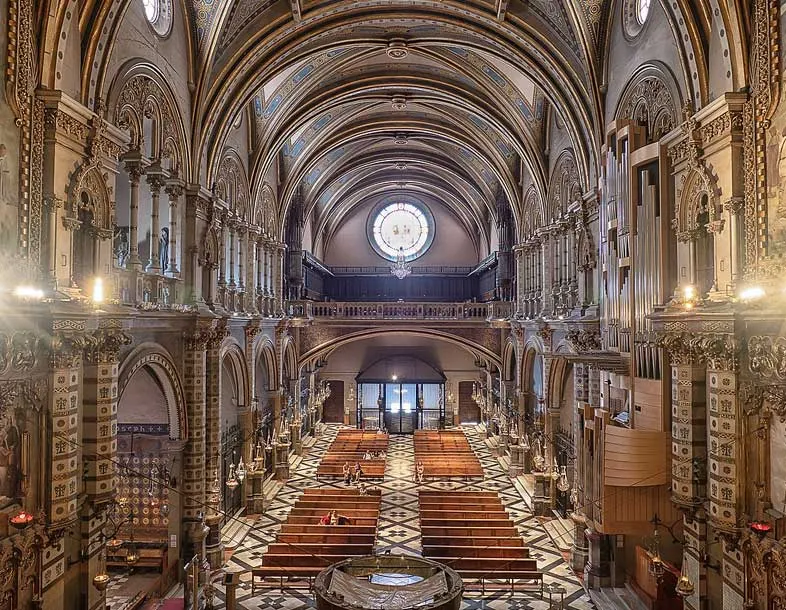
Architectural Styles: Romanesque Architecture, Gothic Architecture, Renaissance Architecture, Eclecticism in Architecture.
The church is of a single nave, 68.32 meters long and 21.50 meters wide, with a height of 33.33 meters. It is supported by central columns, carved in wood by Josep Llimona i Bruguera, representing the prophets Isaiah, Jeremiah, Ezekiel and Daniel. At the head is the main altar, decorated with enamels (1928) of Montserrat Mainar, depicting various biblical scenes, such as The Last Supper, The Weddings of Cana and The Multiplication of Loaves and Fishes. The 15th century cross on the altar is the work of Lorenzo Ghiberti. On the altar there is a shrine of octagonal form. In the chancel there are various paintings by Alexandre de Riquer, Joan Llimona, Joaquim Vancells, Dionís Baixeras and Lluís Graner.
Just above the main altar is located the room of the Virgin that is accessed after crossing a portal of alabaster (Porta Angèlica) in which are represented various biblical scenes, work of Enric Monjo (1954). The mosaics on the walls represent the Saints Mothers (left) and the Saints Vírgins (right), the work of the friar Benet Martínez. Next comes the Throne Room (1944-1954), the work of Francesc Folguera, decorated with paintings by Josep Obiols (Judit who Cuts Off Holofernes’s Head, Esther’s Wedding with the Persian King Asuero) and Carlo Maratta (Birth of Jesus). The Fountain of the Virgin is also found here, with reliefs of Charles Collet representing the miracles of Jesus.
The Throne of the Virgin is embossed silver, work of the goldsmith Ramon Sunyer, with two reliefs made by Alfons Serrahima and designed by Joaquim Ros i Bofarull that represent the Nativity and the Visitation, and an image of St. Michael by Josep Granyer. Here is a 12th century statue of the Virgin on which are placed some angels that hold the crown, the scepter and the lily of the Virgin, the work of Martí Llauradó, covered by a baldachin. The Sala del Cambril is a circular chapel with three apses, built between 1876 and 1884 by Villar i Carmona with the collaboration of his assistant, a young Antoni Gaudí.
The vault is decorated by Joan Llimona (The Virgin Welcomes the Romeros) and the figures of angels and the sculpture of St. George are of Agapit Vallmitjana. The windows are of Antoni Rigalt i Blanch. The exit of the room is carried out by the Camí de l’Ave Maria, where it is customary to make offerings in the form of candles. Here stands out a statue of the Angel of the Annunciation by Apel·les Fenosa, as well as a maiolica ceramic depicting the Virgin, the work of Joan Guivernau.
Around the central nave there are several chapels. On the right are the Saint Peter chapel with the image of St. Peter by Josep Viladomat (1945); the St. Ignatius of Loyola chapel by Venanci Vallmitjana with a painting of the St. Ignaitious by Ramir Lorenzale (1893); the St. Martin of Tours chapel, work of Josep Llimona, with the images of St. Martin, St. Placidus and St. Maurus (1898); the St. Joseph Calasanz chapel with an altarpiece of Francesc Berenguer (1891); and that of St. Benedict with a painting of the founding saint of the Benedictine Order (1980) by Montserrat Gudiol.
On the left are the chapel of Santa Escolàstica, with sculptures (1886) by Enric Clarasó and Agapito Vallmitjana; the chapel of del Santíssim (1977), work of Josep Maria Subirachs, with a singular image of Christ realized in negative, where only the face, the hands and the feet are seen, with a light that illuminates the face to him; the Holy Family chapel, where the painting The Flight to Egypt, by Josep Cusachs (1904); the Santo Cristo chapel, with an image of Josep Llimona (1896); and the chapel of the Immaculada Concepció (1910) a Modernisme work by Josep Maria Pericas, with a stained glass window by Darius Vilàs.
The basilica was restored between 1991 and 1995 by Arcadi Pla i Masmiquel. In 2015 Sean Scully restyled Santa Cecilia Chapel which is next to the abbey.
Virgin of Montserrat (Our Lady of Montserrat)
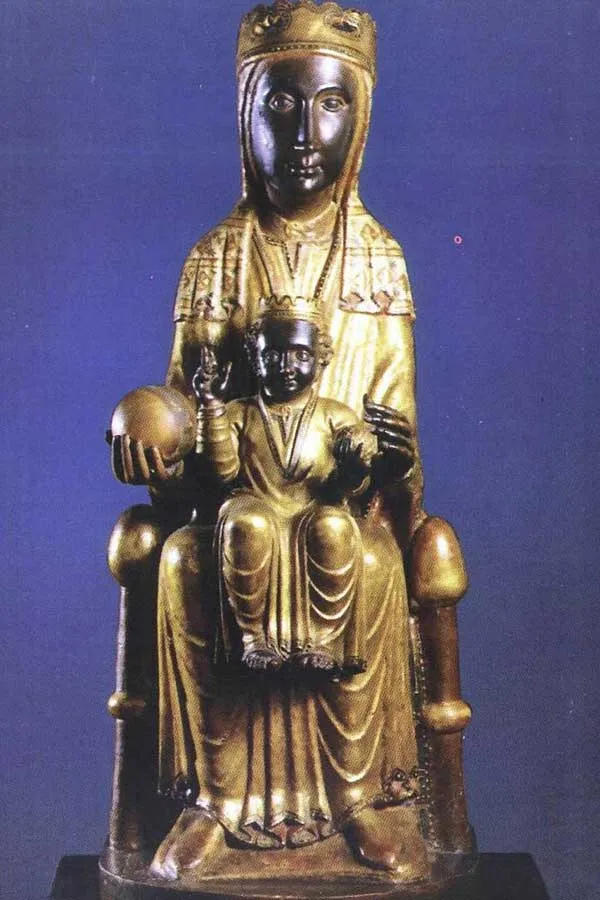
Our Lady of Montserrat or the Virgin of Montserrat is a Marian title associated with a statue of the Madonna and Child venerated at the Santa Maria de Montserrat monastery on the Montserrat Mountain in Catalonia, Spain. She is the Patron Saint of Catalonia, an honour she shares with Saint George. Miracles have been attributed to the statue.
The image of Our Lady of Montserrat, popularly known as La Moreneta (“the little dark-skinned one” or “the little dark one”) due to the dark colour of her skin, is a truly beautiful 12th-century Romanesque polychrome carving. Pope Leo XIII proclaimed Our Lady of Montserrat Patron Saint of Catalonia in 1881. In 1947, the image was enthroned in a silver altarpiece, paid for by popular subscription and installed in the upper section of the basilica apse.
Artistically, the image imitates a popular model of Our Lady Majesty, with a wholly frontal attitude and Baby Jesus on Her lap in the center. Both Mother and Child are wearing crowns.
The figure of Our Lady stretches out her right hand, which holds the globe, symbolising the cosmos. Our Lady nearly rests her left hand on the Child’s shoulder, indicating that this omnipotent king is Her Son. With his right hand, the Child gives a blessing, whilst His left hand holds a pinecone, symbol of fertility and everlasting life.
Pope Leo XIII granted the image a Canonical coronation on 11 September 1881. Believed by some to have been carved in Jerusalem in the early days of the Church, it is more likely a Romanesque sculpture in wood from the late 12th century.
An 18th century polychromed statue of the same image is also displayed in Saint Peter’s basilica, previously stored in the Vatican Museums which was gifted by the President of Brazil, Joao Goulart on the Papal election of Pope Paul VI in 1963. The image has been on display for Papal masses since the Pontificate of Pope Benedict XVI.
History of Our Lady of Montserrat
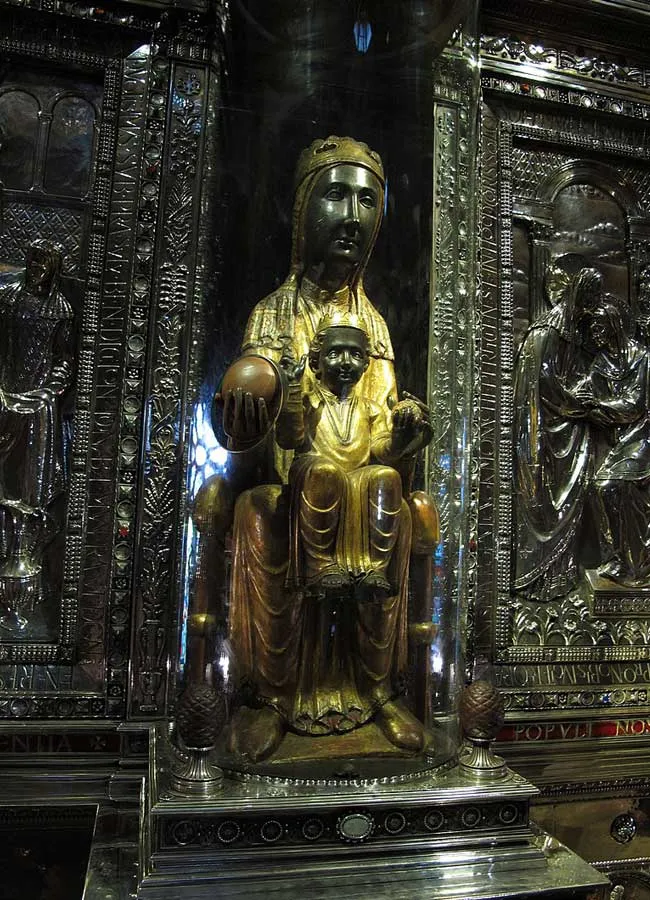
The mountain of Montserrat has been of religious significance since pre-Christian times, when the Romans built a temple to honor the Roman goddess Venus. By one account, the image of the Madonna was moved to Montserrat in 718, to avoid the danger posed by invading Saracens.
Legend has it that the Benedictine monks could not move the statue to construct their monastery, choosing to instead build around it. The statue’s sanctuary is located at the rear of the chapel, where an altar of gold surrounds the icon, and is now a site of pilgrimage.
The 95-cm (38-inch) statue shows evidence of Byzantine conventional and stylized form, and is painted in polychrome. The reliquary statue of Sainte-Foy in Conques (southern France) may have been a model. The art-historical designation for this type of pose is called “Throne of Wisdom”. The body is thin, the face elongated. She holds an orb of the earth in her right hand. The Child’s hand is raised in a formalized and traditional Eastern blessing.
In 2001 renovators working for the government observed that the black hands and face of La Moreneta had over the centuries undergone a change in colour. They attribute the change from a lighter tone to black either to prolonged exposure to candle smoke or a chemical reaction caused by a varnish used as a paint sealant. The statue was repainted black by successive generations of restorers. A series of tests, including X-rays, revealed the statue’s original colour and also showed that the last repainting took place at the turn of the 18th century.
Veneration
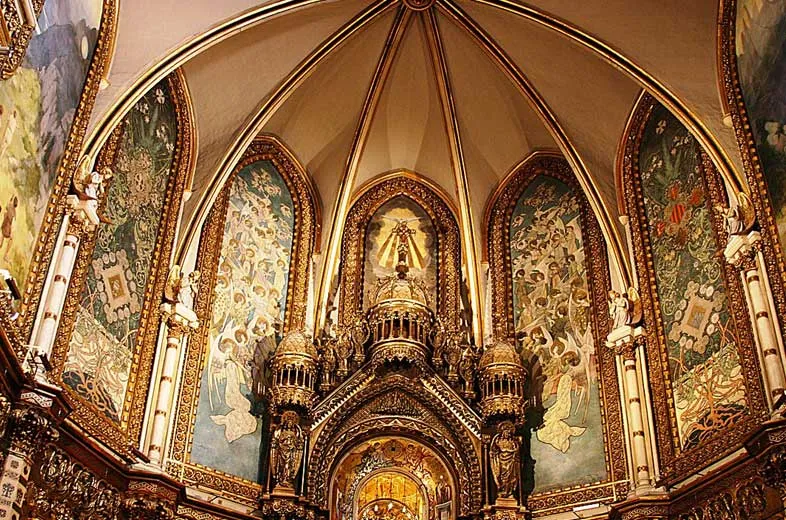
After making a pilgrimage to Our Lady of Montserrat around 1203, Peter Nolasco went to Barcelona where he began to practice various works of charity. Nolasco became concerned with the plight of Christians captured in Moorish raids and decided to establish the Merecedarians, a religious order to succor these unfortunates.
Upon his recovery from battle wounds, Ignatius of Loyola visited the Benedictine monastery of Montserrat (on 25 March 1522), where he laid down his military accoutrements before the image. He then led a period of asceticism before later founding the Society of Jesus.
The hymn to the Virgin of Montserrat, known as “el Virolai” and sung at noon each day by the Escolania de Montserrat boys’ choir, begins with the words: “Rosa d’abril, Morena de la serra…” (Rose of April, dark-skinned lady of the mountain…). Therefore, this virgin is sometimes also known as the “Rosa d’abril”.
The statue has always been considered one of the most celebrated images in Spain. “La Moreneta” is one of Catalonia’s two patron saints, together with Sant Jordi (Saint George).
The Legend
The first text which makes reference to the legend dates from 1239, a fact which demonstrates that Montserrat has been a holy place for many years, due to both the presence of the Image of the Holy Mother of God and the pilgrims coming to worship it.
The legend tells that in the year 880, on a Saturday night when the sun was going down over Montserrat, some boy shepherds saw a bright light coming down from the sky, accompanied by beautiful music. The following Saturday they returned with their parents. And the vision came to them again. On the following four Saturdays the Rector of Olesa went with them. And everyone saw the vision.
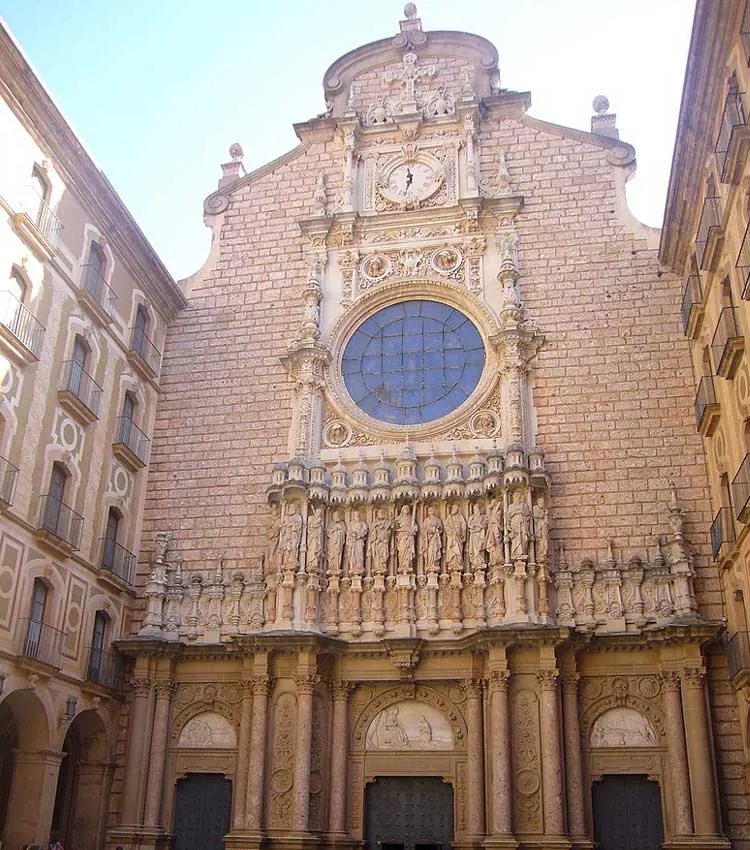
Spiritual Visit to Our Lady of Montserrat
The Spiritual Visit to Our Lady of Montserrat was written by the priest Josep Torras i Bages in February 1889 (the next October was named bishop of Vic) at the request of a group of young people, which had founded the Spiritual League of Our Lady of Montserrat.
In 1981, on the occasion of the centenary of the patronage of Our Lady of Montserrat, in the vigil of Saint Mary, was pronounced for the first time a new Spiritual visit that had been asked to the Catalan Pere Casaldàliga, bishop of Saó Félix (Brasil). This prayer, instead of inserting the Ave Maria and Gloria among the different requests, it can be sung with the melody composed by Brother Odiló M. Planàs, the antiphony: “Saint Mary, Virgin and Mother of God, intercede for us near of the Lord, our God”.
The Brotherhood’s Objective
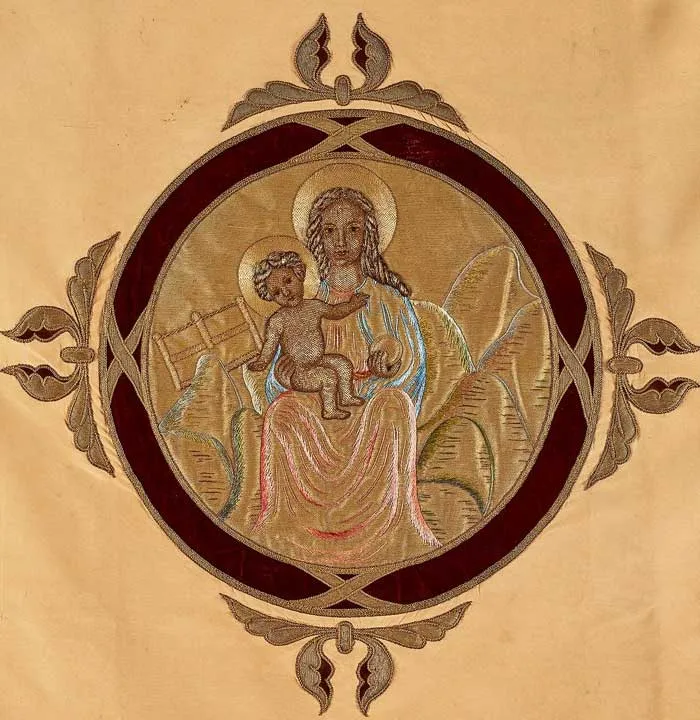
The objective of the Brotherhood is to spread and to ease the worship to Our Lady of Montserrat, linked to the Sanctuary and creating centres, which, like small sanctuaries, approach the love that God show in his Holy Mountain to all believers. This is done with the personal prayer and, especially, organizing the celebrations for the Virgin’s Solemnities: 8th September and 27th April.
Every year, the first Saturday after the 27th April, the members of the brotherhood are invited to go up to Montserrat for taking part in a celebration in the Sanctuary, in which is given to the new members a commemorative card and a medal of the Brotherhood. As well, the first Saturday after 8th September, they are invited to take part in a Mass of suffrage for the members deceased.
The Brotherhood has a head office in the Sanctuary and associated centres, spread around the world, which take part in the life and the prayer of Montserrat. For becoming a member of the Brotherhood, you should register in any associated centre or in the head office of Montserrat. The members of the Brotherhood don’t have particular obligations, but it is recommended an active life of prayer. For easing it, the Sanctuary, common house of all members, will propose materials for personal prayers or in group. It is also recommended to take part in the activities that the Brotherhood organises in the associated centres.
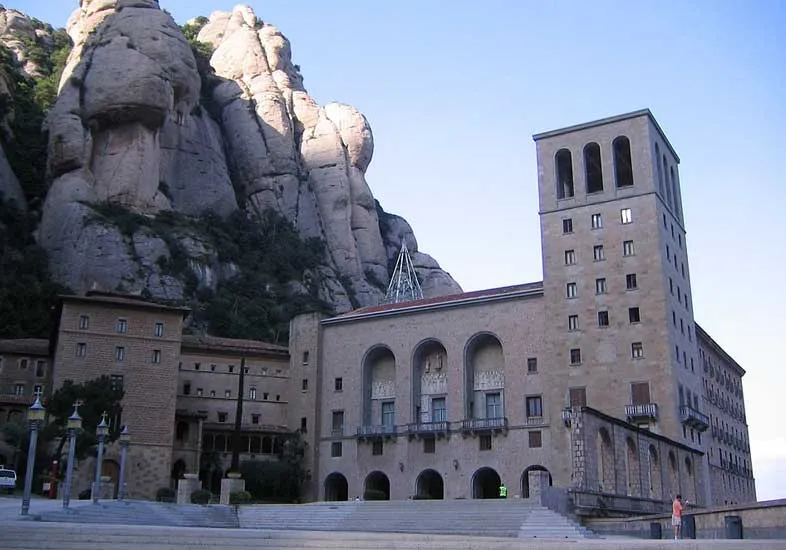
The Crypt
A small located in the right-hand side of the Presbytery, at the side of the niche chamber itself, leads down to the Crypt. This sober harmonious barrel-vaulted room was opened in 1951 and designed as the burial place for Aboot Antoni M. Marcet and the monks who gave their lives to Christ in the civil war of 1936-1939.
The tombs are placed in two vaults opened in the wall; each has a Carrara marble gravestone engraved with details of the remains contained in the vault. At the back of the room there is a memorial stone to those monks whose remains could not be found. The body of Abbot Marcet lies in a sarcophagus designed by Joan Rebull in the centre of the room behind the altar.
In the sides walls are also to be found the tombs and gravestones of Cardinal Anselm M. Albareda, the Abbots Gregori Sunyol, Aureli M. Escarré, Gabriel M. Brasó and Pere Celestí Gusí, all the monks of Montserrat, of Fr. Bernardo López, who was abbot at the Monastery of Our Lady of Montserrat in Manila, and of Bishop Antonio Urbss of Latvia together with his secretary, both of whom died in exile at the Monastery.
Pipe Organ
The pipe organ of the church of Montserrat dates from 1896 and was moved to the presbytery in 1957. This pipe organ is very deteriorated. A new pipe organ was inaugurated in 2010 and follows the design of the Catalan pipe organs that are located next to the Church. It is an important work of Catalan musical craftsmanship that places Montserrat at an international musical level.
This pipe organ is designed by Albert Blancafort, built by Blancafort, orgueners de Montserrat, and financed by popular subscription and the social work of the Caixa de Penedes. The pipe organ is located on the side of the nave, as is traditional in Catalonia, offering a very good sound throughout the temple.
Cloister
The cloister of the monastery is the work of the architect Josep Puig i Cadafalch (1929). It is two floors, supported by stone columns. The lower floor communicates with the garden and has a fountain in its central area. On the walls of the cloister, the visitor can see old pieces, some of 10th century.
The extensive garden includes the Chapel of Sant Iscle and Santa Victòria, Romanesque, access to the buildings of the novitiate and the choir and several sculptures, such as the marble of the “Good Shepherd” of Manolo Hugué or some of the sculptures that Josep de San Benet made in the 18th century for the bell tower of the monastery and that were never installed.
Refectory
The refectory is from the 17th century and it was rebuilt in 1925 by Puig i Cadafalch. The central part has a mosaic that represents Christ, while in the opposite area the visitor can see a triptych with scenes from the life of St. Benedict.
Museum
The monastery has an important museum divided into three different sections:
Modern painting, with works by artists from Catalonia such as Santiago Rusiñol, Ramon Casas, Isidre Nonell, Joaquim Mir, Salvador Dalí, Joan Miró and Antoni Tàpies, and non-Catalans like Pablo Picasso or the painter Darío de Regoyos, Asturian, who was the only painter linked to the European impressionist and neo-impressionist movements; as well as a representation of French impressionism, with authors such as Pierre-Auguste Renoir, Claude Monet, Alfred Sisley and Edgar Degas.
Archeology of the biblical East, showing objects of Egypt, Cyprus, Mesopotamia and Holy Land.
Ancient painting, showing works by authors such as El Greco, Caravaggio (from this author, an important St. Jerome), Luca Giordano, Giambattista Tiepolo and Pedro Berruguete.
Other collections include Montserrat iconography and religious goldsmithing.
The Holy Cave
The path which leads to the Santa Cova (Holy Cave) starts near the cable car and continues for about one and a half kilometres along a route established in the seventeenth century. Financial support from the faithful contributed to the fifteen sculptural groups corresponding to the fifteen Mysteries of the Rosary set up along the route. Gaudí, Puig i Cadafalch, Josep Limona, the Vallmitjana brothers and others all worked on these pieces of sculpture.
Almost hanging from the rock at the end of the route is the Chapel where legend has it that the Image of Our Lady of Montserrat was found. The current building is by and large the same as the seventeenth century building which was rebuilt twice, firstly because of the damage suffered in the Napoleonic Wars in 1811 and later after damage caused by the fire in 1994 and the collapse of the dome in September 1995.
There are some out buildings used as a dwelling by the monk who welcomes pilgrims there and a charming small cloister. The simple small chapel, built to the design of a Greek cross and dome, backs onto a grotto in the mountain, where there is a stylised reproduction of the authentic Image in the Basilica. The entire place is peaceful and solitary.
Feast Day – 27th April
The feast of the Virgin of Montserrat, Patron Saint of Catalonia, is celebrated on the 27th of April. The Vigil of the feast is also celebrated the previous day.
Mass Time
Weekdays
Saturdays
Sundays
Church Visiting Time
Contact Info
08199, Montserrat, Catalonia,
Barcelona, Spain
Phone No.
Tel : +34 938 77 77 77
Accommodations
How to reach the Montserrat Abbey
Josep Tarradellas Barcelona–El Prat Airport also known as Barcelona Airport in Catalonia, Spain is the nearby airport to Montserrat Abbey.
Monistrol de Montserrat Transit Station in Barcelona, Spain is the nearby Transit Station to Montserrat Abbey.

